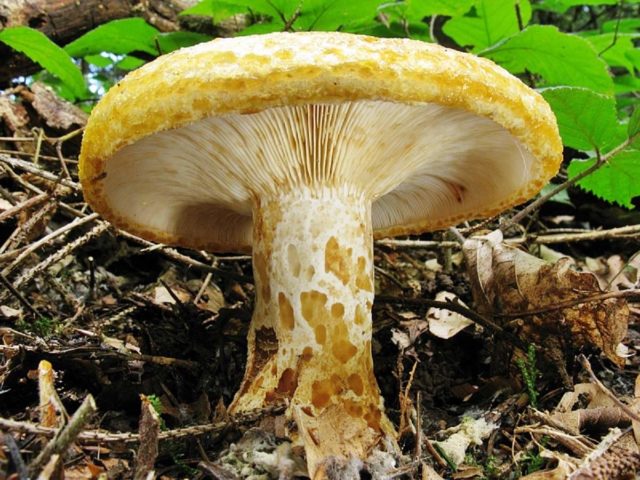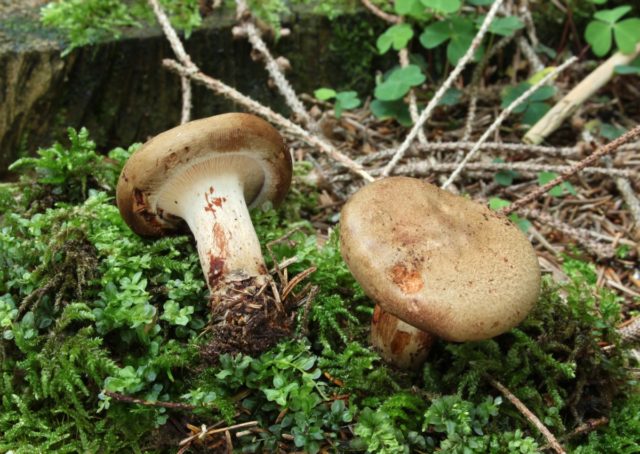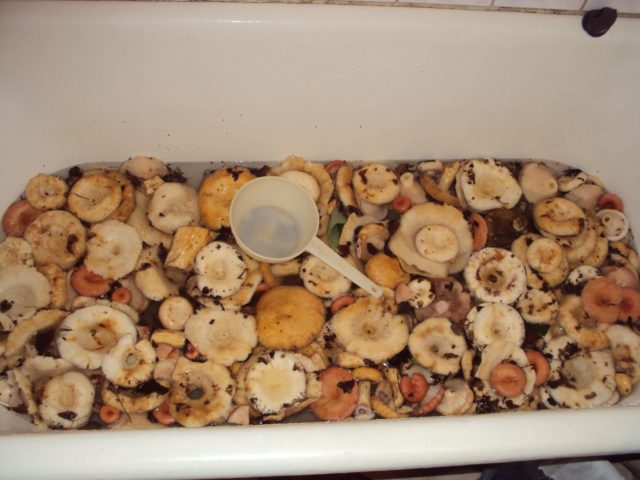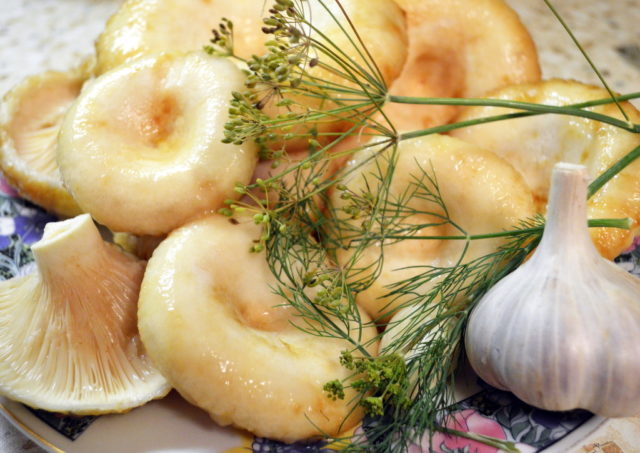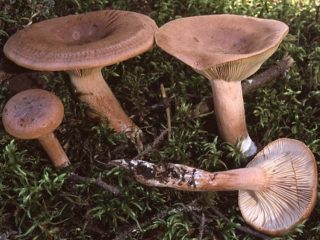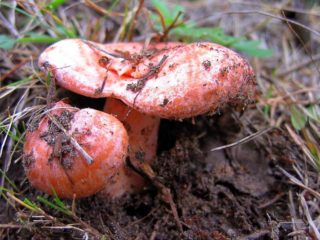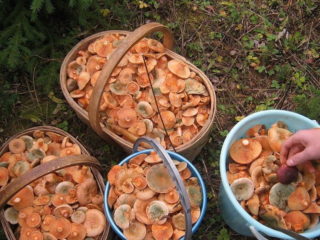Content
Descriptions of yellow milk mushrooms with a photo are found in many culinary and cookbooks. Indeed, salted mushrooms are a traditional dish of Russian cuisine and a kind of visiting card of our country. therefore mushroom yellow milk mushrooms, the photo and description of which are given in this article, together with their white counterpart, occupy far from the last place in restaurant menus. And this is absolutely justified.
What does a yellow lump look like?
Yellow milk mushroom (yellow wave, scrapes) is a lamellar mushroom from the Millechnik genus, the Syroezhkov family. Its distinctive feature is a dirty yellow or golden olive hat with clearly distinguishable dark concentric circles. At the beginning of life, the cap is convex; as the fungus grows, it becomes flat, and then funnel-shaped. It can reach significant sizes - up to 25cm. The yellow mushroom is shown in the photo below.
The pulp of the fruit body is dense, white, brittle. It has a pronounced fruity odor, turns yellow on the cut, emitting a thick, milky, yellowish juice that darkens over time. The leg is straight, short, hollow inside, has small yellow pits along the entire surface.
The cap and leg of the mushroom, especially in wet weather, are often covered with a sticky coating. The often located plates located on the lower side of the cap slightly pass onto the stem. Brown or reddish spots appear on them as they age.
The difference between a yellow milk mushroom and a pig
Pigs are yellow-brown mushrooms that look like milk mushrooms. They are poisonous. Until recently, the pig was considered conditionally edible, but the existing cases of death after its consumption led to a change in the classification. It is rather difficult to confuse it with a yellow milk mushroom; rather, you can mistake it for a black mushroom. The pig has a dark cap, its flesh is light brown in color, darkens on the cut. The plates are easily detached from the cap.
The leg is smooth to the touch, matte, slightly lighter than the cap.
Poisonous mushrooms that look like yellow milk mushrooms
There are no poisonous mushrooms with which yellow waves could be confused. In appearance, the scrapes are similar to real milk mushrooms, with a lighter color. There is also another yellow mushroom that looks like a mushroom. It is not poisonous, but simply not as tasty as the real one. This is the so-called purple (blue) lump. It has a lower nutritional value and is only suitable for salting. It looks like an ordinary yellow milk mushroom (photo at the beginning of the article), however, characteristic purple spots can appear on the plates and on the cap.
You can also distinguish it from yellow by the color of the milky juice that stands out on the cut. The milky juice of a real yellow breast is yellowish, and in purple it is lilac.Milk yellow false (purple, blue) - in the photo below.
Where yellow milk mushrooms grow
Most often, yellow milk mushrooms grow in groups, usually in conifers, less often in mixed forests. Often they form mycorrhiza with spruce or birch. In deciduous forests, they are rare, and it is more difficult to find them there, since often mushrooms are literally covered with fallen leaves.
You can start harvesting yellow waves from the end of August, but their main harvest ripens in September. In a favorable year, you can bring them from the forest until the onset of frost. A prerequisite for the growth of these mushrooms is high humidity; in dry autumn, milk mushrooms may not appear at all.
Due to the presence of a bitter milky juice, these mushrooms are rarely wormy. When harvesting, mushroom pickers usually take only golden-yellow caps of milk mushrooms, with the exception of only young specimens, which are cut and processed entirely.
How to cook yellow milk mushrooms
The yellow mushroom is conditionally edible. Despite this, he, like the real milk mushroom, white mushroom, camelina and chanterelle, is included in the first category of mushrooms with the highest nutritional value. The main way to prepare yellow waves is salting, less often pickling.
Many mushroom pickers are afraid to take it because of the characteristic purple spots, but this precaution is completely unnecessary.
How much to soak yellow milk mushrooms
The collected yellow waves are washed with cold water, clearing them of adhering dirt and debris. To get rid of caustic milky juice, the crop is soaked in cold water for several days, changing it at least 2 times a day. In the old days, milk mushrooms were often soaked for several days in the river.
You can remove the bitterness in another way, boiling the yellow waves for about half an hour, and then draining the resulting broth and rinsing the mushrooms under running cold water. This method is good when there is a shortage of time, but after boiling, the taste of yellow waves changes and not for the better. Therefore, not all mushroom pickers welcome the heat treatment of milk mushrooms, considering this a deviation from the classic salting technology.
What can be cooked from yellow milk mushrooms
Salted yellow milk mushrooms are a classic dish. There are quite a few recipes for salting them, and a significant part of them are zoned. In some regions they prefer to add currant leaves to salting, in others oak or cherry leaves. However, the basis of the recipe is always the same.
The main ingredients are mushrooms, salt and water, in addition, garlic, dill, leaves or horseradish root, currant or cherry leaves, pepper and other components can be added. Often, yellow milk mushrooms are pickled, using, as a rule, young mushrooms of small size. After salting, some mushroom pickers finely chop and fry them with onions, using them as an addition, for example, to boiled potatoes, and also as a filling for pies.
How to cook yellow milk mushrooms
After washing and soaking in cold water or boiling, the mushrooms are washed again. After that, they are ready for salting. It is produced as follows. At the bottom of the prepared container, leaves of currant, horseradish or cherry, a sprig of dill are placed. A layer of mushrooms is spread on them and sprinkled with salt. Next, lay out the next layer, and so on until the container is completely filled.
The amount of salt can be different and depends on the taste; on average, take 50 g of salt per 1 kg of mushrooms. After the last layer is laid out, the milk mushrooms are covered with currant or horseradish leaves on top, and then put under oppression. After about a week, you can try the mushrooms.
Pickling is another popular way of storing these mushrooms for future use.It is carried out as follows. The collected mushrooms are soaked in water for half an hour so that all the dirt adhering to them is soaked. After that, they are rinsed under running cold water; for better cleaning, you can use, for example, a toothbrush. Using a knife, the top layer is peeled off from the cap, and the plates are also removed. Chop large mushrooms.
After that, they are put in a saucepan, filled with water and put on fire. You need to cook for at least a quarter of an hour, stirring constantly and skimming off the foam. Then the mushrooms are washed with cold water, put back in a saucepan and boiled for another half hour. After that, the mushrooms are removed from the heat, discarded in a colander and washed with cold water.
To prepare the marinade, you will need water, salt, sugar, and spices:
- pepper;
- cloves;
- Bay leaf;
- dill.
All ingredients are placed in water, after which the pan is put on fire and boiled for 15 minutes. After this time, vinegar is added to the marinade. Chopped garlic is placed in sterilized jars, then mushrooms are placed and poured with hot marinade. After that, add a little vegetable oil, twist the jars.
Conclusion
The description of yellow milk mushrooms with a photo given in this article is far from complete and is for informational purposes only. More information about these mushrooms and how to prepare them can be found in the specialized literature. And in order to protect yourself and your loved ones from possible troubles associated with the use of forest gifts, you always need to remember the golden rule of the mushroom picker: I don't know - I don't take it.
